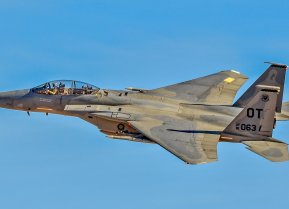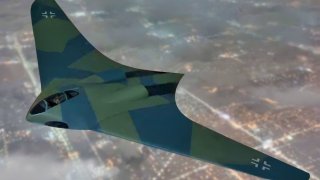Horton Ho 229: Did Nazi Germany Build the First Stealth Bomber?
The Horten Ho 229 is often classified as a "stealth aircraft," and the Horten brothers had indeed been correct that the flying wing concept would make it less visible to radar than a conventional aircraft of its size.
Nazi Germany's Flying Wing or Stealth Bomber? The Horton Ho 229 - By the end of the decade, the United States Air Force will begin to phase out many of its Cold War-era bombers with the new Northrop Grumman B-21 Raider. The advanced, very long-range, heavy-payload stealth intercontinental strategic bomber will be the latest U.S. military aircraft to feature a flying wing design.
The concept of the "flying wing" dated back to the Second World War when Walter and Reimar Horten began work on the revolutionary Horten Ho 229 jet fighter. As development only began as Nazi Germany was already well on its way to losing the war, progress was slow going – and even had it been built, it likely would have done little to change the war's outcome.
However, the aircraft has remained one of fascination due to its unique design.
Prototypes Were Built
Unlike many other Nazi "super weapons" that barely made it off the drawing board, multiple prototypes of the Horten No. 9 (H.IX) were actually produced. The first prototype was completed as glider, the second and third were single-seat aircraft, while and the fourth was intended to be a two-seater.
Today, only a portion of one of those prototype airframes remains. It includes the twin jet engines, delta shape, steel fuselage and cockpit. It is now in the collection of the Smithsonian National Air and Space Museum.
The Horton Ho 229 Was a Rather Low Tech Aircraft
Despite the cutting-edge design, the aircraft wasn't really all that high-tech. According to a report from military aviation analysts at Jane's, "the sharply swept-back cantilever wing was of mixed construction with a welded steel-tube center-section, wood outer sections and metal tips" and added, "all control surfaces were on the outer wings. Divided hinged surfaces were responsible for longitudinal and lateral control and spoilers for direction control."
Horton Ho 229: Was it a Stealth Aircraft?
The Horten Ho 229 is often classified as a "stealth aircraft," and the Horten brothers had indeed been correct that the flying wing concept would make it less visible to radar than a conventional aircraft of its size. It would have had only about 80 percent of the visibility presented by a fighter such as the Messerschmitt Bf 109 despite having a larger wingspan.
Moreover, as TheAviation Geek Club noted, "claims by Reimar Horten that he had mixed charcoal with the glue to bond the wood laminates of which the structure was made in an attempt to achieve a low reflection were rebuffed by a chemical analysis which showed there was no evidence of such a substance."
Horten had suggested the carbon charcoal, which would have significantly absorbed propagated radio waves, was also to have been used in production versions. Whether it could have further reduced the radar signature is one that will remain a matter of debate.
The Allies Built One, Too
It wasn't just the Germans who tried to build a flying wing. During World War II, Northrop built its N-9M, a one-third scale all-wing prototype. That was used in the development of the Northrop XB-35 and YB-35, an experimental heavy bomber build for the United States Army Air Forces shortly after World War II.
Northrop's pioneering all-wing design eventually lead Northrop Grumman to develop the advanced B-2 Spirit stealth bomber that entered service with the United States Air Force in the late 1980s.
The Horton Ho 229 Inspired Movie Makers
Nearly a decade before the American public ever heard of the B-2, many saw a flying wing on screen in the 1981 film Raiders of the Lost Ark, in which the Nazis planned to use an experimental aircraft to fly the Ark of the Covenant back to Germany. It is never explained why the Nazis are using such a plane, and the only apparent reason is that director Steven Spielberg liked the concept.
It wasn't a real plane of course, and was created by production designer Norman Reynolds, based on the Northrop designs from the Cold War, as well as from drawings of the Horten Ho 229. The prop was produced by Vickers Aviation, yet it wasn't airworthy and had to be disassembled to transport it to the film set in Tunisia. The sole prop was actually blown up in an explosive sequence in the film!
More recently, a much more massive flying wing aircraft was seen in the 2011 film Captain America: The First Avenger. Unlike the static prop, the flying wing that the Marvel superhero battled was the result of CGI.
About the Author
Peter Suciu is a Michigan-based writer who has contributed to more than four dozen magazines, newspapers and websites. He regularly writes about military hardware, and is the author of several books on military headgear including A Gallery of Military Headdress, which is available on Amazon.com. Peter is also a Contributing Writer for Forbes.


